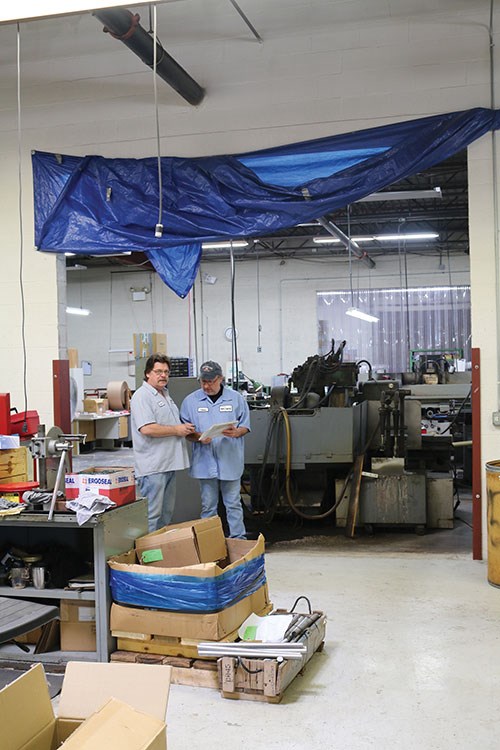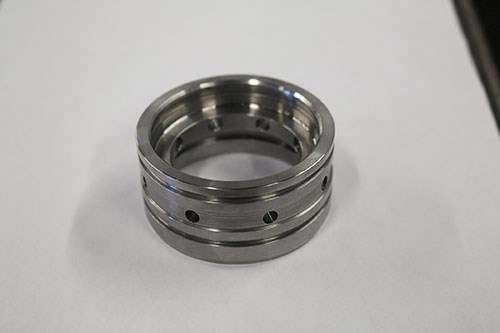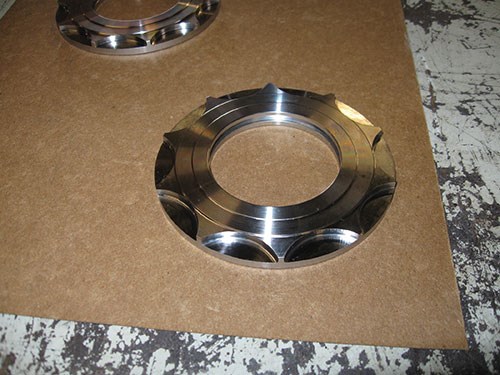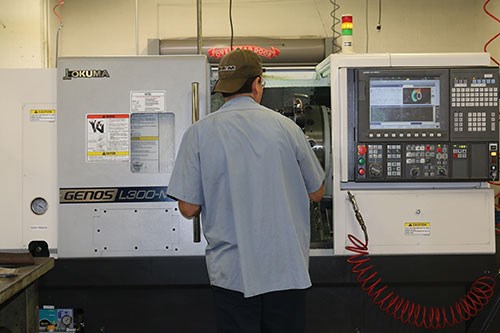The Acquisition Next Door
A Chicago-area maker of mechanical seals purchased the die maker adjacent to it in the same building. The seal maker’s CEO says the way to expand is by capitalizing on the opportunities that come.
When Ergoseal purchased Sieber Tooling Solutions last year, the two Chicago-area manufacturers soon began to learn from one another. Cold forming tool and die maker Sieber understood setups. The experienced employees here are efficient at setting up single-piece or short-run orders quickly. Meanwhile, machinery seal maker Ergoseal understood sequential operations. The team here was experienced with efficiently running parts in need of turning, milling and drilling using live-tool lathes as well as milling and turning machines in series. To begin to share this knowledge and experience, the employees of the respective companies simply had to step through a hole that had been opened in the wall between them.
The two firms were neighbors. More than just Chicago-area companies, the manufacturers in fact occupy adjacent units of the same industrial building in Carol Stream, Illinois. Ergoseal owns this building and was looking to expand. When it asked Sieber’s European parent to relocate its shop one unit over, the landlord learned that the European company was contemplating ending manufacturing in the United States. Therefore, seeing an opportunity not just to expand square footage but also to expand its machining capacity, Ergoseal offered to buy the U.S. shop. The deal was struck, the acquisition was made, and Ergoseal united the two companies by opening the wall that had formerly separated them.
The pooling of experience that has proceeded since then illustrates, among other things, the insularity that is so common to manufacturing businesses. An inward focus is understandable for manufacturers, because the daily challenges of the shop floor are consuming. Still, Ergoseal President and CEO Tom Hilaris realizes with amusement today that the two companies could have shared helpful manufacturing knowledge easily even before they were joined. They could have explored one other’s shops. They could have stepped easily through their two adjacent front doors. They could have compared notes on one particular cutting tool they were both using. They didn’t do any of this, because both companies were so busy.
In fact, they might even have discovered and solved one another’s problem. Sieber had a bottleneck: Jobs often queued at the machining center. Ergoseal had a surplus: The shift to live-tool lathes meant it now had one more machining center than it needed. As soon as the two companies joined, this mirror-image set of problems was one of the first opportunities for synergy to be found. When a VMC was passed through the wall from Ergoseal to Sieber, the move immediately improved the balance of capabilities for both shops.
Ready and Watching
We reported on Ergoseal early in 2014 in an article titled, “Get Ready for Growth.” Prior to last year, that is what the custom seal maker was doing: introducing changes (such as enterprise resource planning software and live-tool turning machines) to improve the efficiency of its production processes so those processes would be easier to scale when the company realized its intention of growing bigger in sales and output.
As for how to actually realize this growth, Mr. Hilaris says there was no concrete series of steps to follow. The company deliberately got ready for growth, but the next step was to watch for opportunities and seize upon them when they came. Two such opportunities arrived last year, the second of which was Sieber. Just before the tool and die shop became available, Ergoseal also purchased another seal maker, Norman Technology.
Norman was not a competitor. Ergoseal, like Norman, had always focused on custom seals, but Ergoseal’s business was built on seals of a different type than Norman’s. A “seal” is the hardware fitting connecting two machine components to ensure there is no fluid leakage at their juncture. On certain pump systems, seals can be challenging components to design. Ergoseal’s strength was (and still is) the engineering capability resulting from in-house seal designers working with in-house manufacturing staff. But Mr. Hilaris says the company’s challenge has often been just getting in the door with potential customers. In a market as established as that of machinery seals, smallness is a significant hurdle. The prospect sees the unfamiliar name and asks, “Who are you?” Norman, a specialist in seal types complementary to Ergoseal, was a company of similar size facing precisely the same problem.
But together the two companies would not be small. Merged into one, the resulting firm could offer an expanded range of products and services across the combined customer list of both. In fact, combining Ergoseal and Norman would enable the customers of both to do something many of them had long wanted to do: consolidate onto one supplier for all seal purchases.
In acquiring Norman, Ergoseal obtained the product line, the customer list and certain staff members. (Norman’s president joined Ergoseal as director of engineering. The general manager joined as operations manager.) However, Ergoseal did not take on the machining capacity. Shipping the existing machine tools from Norman’s shop in California would not be worth the expense compared to liquidating them where they were. Ergoseal expected instead that it would meet the manufacturing capacity need of the newly expanded company by expanding its current shop to a second shift.
There would be challenges in this, Mr. Hilaris says. Norman’s was a different kind of manufacturing. Standard products Norman produced, such as lip seals and mechanical seals, were ordered in smaller quantities than the custom-engineered seals Ergoseal was accustomed to producing, because these custom seals generally are ordered in volumes that justify the customization. Just how different the smaller-batch machining would be, and how the staffing and pacing of Ergoseal’s shop would have to change to accommodate this kind of production, is a question the company was about to face. Then came the chance to buy a shop next door that happened to specialize in small-batch manufacturing.
Machine Transfer
Sieber’s expertise at performing setups quickly is a natural result of the market it serves. Making dies and related tooling inherently means making short-run or one-off parts. Where Ergoseal has always been accustomed to running batches numbering in the hundreds, Sieber is more accustomed to batches of no more than 20. Anticipating setups, preparing for setups and moving to perform setups quickly is not the result of any special technique or secret, but instead something harder to obtain: the culture and habits of the people in the shop, and the overall organization of a shop that is focused on small-batch work.
The machining done on a vertical machining center at Sieber perhaps comes nearest to
resembling the production that Ergoseal performs. This machine makes grippers and other tooling components related to cold forming, machining parts such as these in batches of a dozen or more. The ability to set up many parts on this machine’s table and run them in a single long cycle makes the machine efficient, but still not efficient enough to keep pace with all of the parts this machine needs to make related to jobs being run on other equipment throughout the shop. The previous parent company, because it was questioning whether to continue with U.S. production, had been reluctant to invest to address this bottleneck.
Meanwhile, the staff at Ergoseal was getting increasingly proficient with its use of live-tool turning machines capable of performing various machining operations in a single setup. After successfully applying its first live-tool lathe to streamline the processing of one particularly high-demand set of part numbers, the company bought more machines of this type and continued transitioning parts formerly machined in multiple setups on a separate lathe and machining center into single-setup processes. In this way, the shop found itself with one more machining center than it needed, and that machine went to Sieber. Employee Mark Theurer, who had run the previous Sieber machining center, now runs the two machining centers together.
All of this might seem a little strange, Mr. Hilaris admits. Ergoseal is now in the forming-die business, where he never expected the company to be. But it’s not that strange; the work is still machining, he says, and the Sieber shop is proving to be an excellent answer to Ergoseal’s need for increased production. This chance to have an expanded day shift—that is, a larger facility with an expanded staff of people who are all at work at the same time—is preferable to the expansion into a second shift that the shop was contemplating. In fact, Ergoseal wishes it could give more of its seal machining to the Sieber shop, but continued success in die machining is proving to be the impediment to this. With its grinding machines, Sieber ought to be the source for Ergoseal’s grinding needs, but Ergoseal is still sending this work away because there is so much customer work in the queue for the Sieber grinders.
Thus, the two facilities are not fully in sync yet. That’s OK—they don’t have to be. For now, Mr. Hilaris says he knows where the integration of the two shops needs to begin.
Customer Experience
While the staffs of the two shops cooperate and interrelate, they do remain separate and continue to function differently. To an extent, it is as though there is still a wall between them. That barrier will also be opened over time, Mr. Hilaris says. But the area where the companies need to come together and function identically today is around the question of how jobs come in the door and how they proceed into production. Different companies develop different formal and informal steps as to how this occurs, but those very differences risked miscommunication, redundancy and error when Sieber and Ergoseal merged. This was particularly true given the fact that the die-making business is not yet part of the ERP system that organizes the seal-making business. Procedures had to be formalized around releasing jobs, and habits had to be talked through, so that a single sales and management group could serve effectively as the customer interface for the combined company.
Meanwhile, the best opportunity to share resources between the shops was in the area of quality. In any shop, the utilization of measurement and inspection resources is inherently low. Machine tools are often kept busy, but gages and measurement devices wait for parts in need of inspection, making it easy for these resources to be shared. In addition, expanding two companies to cover the combined markets of both—the case when Ergoseal and Norman merged—meant changing the quality standards for one of them. Ergoseal adopted Norman’s more thorough inspection process because it satisfies the requirements of aerospace, a market Norman served but Ergoseal formerly did not. Creating a new, central quality room shared by both machine shops not only won efficiencies in measurement and inspection, and not only provided room for new measurement equipment such as a vision system, but it also established a place for a newly created position in the combined company: a quality manager.
In focusing on these two areas first—the orders coming into the company and the quality of parts going out—Ergoseal is addressing the two points of the process that directly affect the customer’s experience. If the company can unify these areas of the process, and get these areas right, then it has the freedom to move gradually on integrating the rest of the two shops’ operations. There has been friction, he says. Naturally, there has been pushback from employees on some of the steps that have been taken to make the two shops more unified and alike. But there have also been surprising gains—spontaneous improvements that have come from the employees of one shop seeing, discovering or learning something from the other. The company has time for the manufacturing staffs to grow together slowly, Mr. Hilaris says. For now, he is content to watch this progress as employees from both shops continue to explore what is on the other side of the wall.
Related Content
8 Ways to Increase Productivity on the Manufacturing Floor
When it comes to machine shop productivity, continuous improvement depends on efficient employees, equipment and processes.
Read MoreCan Connecting ERP to Machine Tool Monitoring Address the Workforce Challenge?
It can if RFID tags are added. Here is how this startup sees a local Internet of Things aiding CNC machine shops.
Read MoreIMTS Takeaways From the Modern Machine Shop Editorial Team
The first in-person IMTS in four years left the MMS editorial staff with a lot to digest. Here are a few of our takeaways from the show floor.
Read MoreSolve Worker Shortages With ACE Workforce Development
The America’s Cutting Edge (ACE) program is addressing the current shortage in trained and available workers by offering no-cost online and in-person training opportunities in CNC machining and metrology.
Read MoreRead Next
3 Mistakes That Cause CNC Programs to Fail
Despite enhancements to manufacturing technology, there are still issues today that can cause programs to fail. These failures can cause lost time, scrapped parts, damaged machines and even injured operators.
Read MoreThe Cut Scene: The Finer Details of Large-Format Machining
Small details and features can have an outsized impact on large parts, such as Barbco’s collapsible utility drill head.
Read More
.jpg;width=70;height=70;mode=crop)
























.png;maxWidth=300;quality=90)










